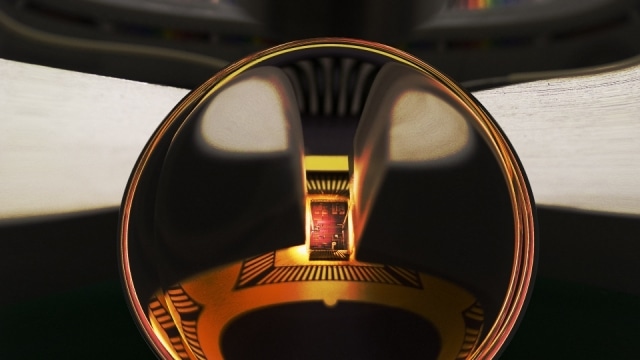Mar 1 2016
Light and matter are not totally different with regard to quantum physics. In specific situations, electrons that are negatively charged can combine together and form a coordinated dance permitting them to carry a current across an imperfect material. That motion, which takes place only if the electrons are restricted to a 2D plane, emerges as a result of a phenomenon referred to as the quantum Hall effect.
 Image of photonic chip and apparatus, which is featured on cover of March 2016 issue of Nature Photonics; (Credit E. Edwards/JQI)
Image of photonic chip and apparatus, which is featured on cover of March 2016 issue of Nature Photonics; (Credit E. Edwards/JQI)
A team of researchers headed by Mohammad Hafezi, a JQI Fellow and assistant professor in the Department of Electrical and Computer Engineering at the University of Maryland, has carried out the very first direct measurement that defines this unique physics in a photonic platform.
The work was published online on February 22 and appeared on the cover page of the March 2016 issue of Nature Photonics.
It is possible to extend these new methods to a lot more complex systems, like the one in which long-range quantum correlations and strong interactions play a significant role.
It is easier to understand the quantum Hall effect through topology. Physicists, in the 1980s, detected that electrons present in a few materials act in a very strange manner when subjected to huge magnetic fields at strong cryogenic temperatures.
It is interesting to note that the electrons existing at the material’s boundary will pass through the travel avenues called ‘edge states’, protected from damages that are very often present in the material.
Besides this, the conductance, which is a measure of the current, is quantized. This refers to the fact that the conductance does not easily change when the magnetic field is increased. Instead the conductance remains flat, like a plateau, and suddenly bounces to a new value.
The plateaus are found at accurate values that stand out from most of the material’s properties. This hopping behavior is a type of accurate quantization and it provides the quantum Hall effect its best utility, thus permitting it to offer the contemporary standard for calibrating resistance in the field of electronics.
The team has invented a quantum Hall behavior in many other platforms a part from the solid-state realm, wherein it was initially discovered. Such physics signatures have been identified in photonics and ultracold atomic gases, where light passes in fabricated chips. Hafezi and team have headed the charge in the field of photonics.
So far, our research has been focused on transporting classical [non-quantum] properties of light--mainly the power transmission. It is intriguing to further investigate if this topological system can also achieve robust transport of quantum information, which will have potential applications for on-chip quantum information processing.
Sunil Mittal, lead author and postdoctoral researcher, University of Maryland
The team employs a silicon-based chip containing an array of resonators, which are ring-shaped structures. These resonators are linked to each other through waveguides. The design of the chip established the conditions under which light can pass through the edges rather than across the inner regions.
The team measures the transmission spectrum, which is the portion of light that successfully travels through an edge pathway. The light is expected to contain a specific energy in order to circulate unimpeded via the edge modes that are protected.
An increase in transmission is detected when the light energy meets this criterion. For other parameters, the light penetrates the interior of the chip or goes astray, thus decreasing the transmission signal. The compiled transmission spectrum appears like a set of bright stripes divided by darker regions.
Earlier, the researchers used such chips and collected images of light passing in edge states, thus explaining the quantum Hall physics for photons.
Hafezi’s team, in this newly developed experiment, brought about changes in the design in order to carry out direct measurements of the value of value of the topology-related property that defines the photonic edge states.
This new experiment is similar to characterizing the quantized conductance, which played a vital role in demonstrating the electron quantum Hall effect. However, conductance is not considered to be relevant as it relates to electron-like behavior.
The winding number here is the most important feature as it is deals with how light moves around the chip. The value is equal to the number of edge states that are available and should not differ in the case of specific disruptions.
The researchers obtained the winding number by adding 100nm titanium heaters on a layer present over the waveguides. The index of refraction is changed by the heat, for instance it highlights how the light bends as it travels through the waveguides.
In this manner, the team was able to accurately imprint a phase shift on the light. Phase can be considered in terms of a time delay. For example, the same intensity can be obtained when comparing two light waves, but one wave can be moved in time compared to the other. Both the waves overlap when one is delayed by a complete oscillation cycle, known as a 2π phase shift.
Adequate heat is added on the chip in order to add a 2π phase shift to the light. The team monitored a shift in the energy in the transmission stripes next to light traveling along the edge.
In this chip design, specifically, it is possible for the light to circulate either in clockwise direor counterclockwise direction and the two travel pathways do not act in the same manner. The CW traveling light jumps to one path in the transmission spectrum, and the CCW jumps to the opposite path when the phase shift is initiated.
The winding number is the quantity that these edge-state spectral characteristics move and is precisely corresponding to the quantized jumps in the electronic conductance.